汉英翻译实践第一讲讲课讲稿
- 格式:doc
- 大小:43.50 KB
- 文档页数:11
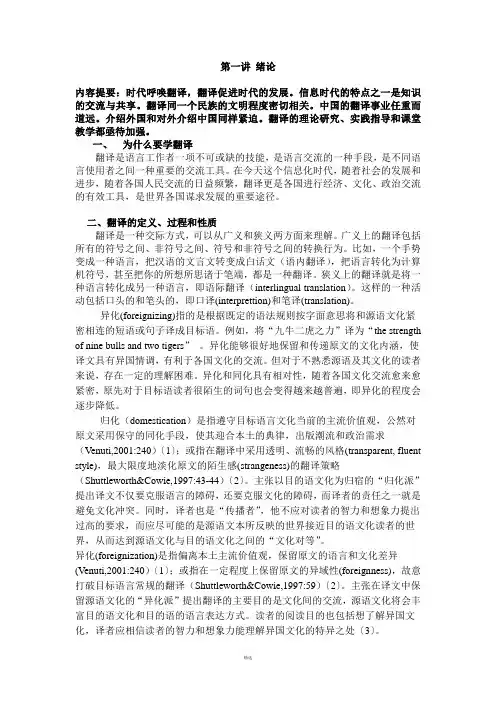
第一讲绪论内容提要:时代呼唤翻译,翻译促进时代的发展。
信息时代的特点之一是知识的交流与共享。
翻译同一个民族的文明程度密切相关。
中国的翻译事业任重而道远。
介绍外国和对外介绍中国同样紧迫。
翻译的理论研究、实践指导和课堂教学都亟待加强。
一、为什么要学翻译翻译是语言工作者一项不可或缺的技能,是语言交流的一种手段,是不同语言使用者之间一种重要的交流工具。
在今天这个信息化时代,随着社会的发展和进步,随着各国人民交流的日益频繁,翻译更是各国进行经济、文化、政治交流的有效工具,是世界各国谋求发展的重要途径。
二、翻译的定义、过程和性质翻译是一种交际方式,可以从广义和狭义两方面来理解。
广义上的翻译包括所有的符号之间、非符号之间、符号和非符号之间的转换行为。
比如,一个手势变成一种语言,把汉语的文言文转变成白话文(语内翻译),把语言转化为计算机符号,甚至把你的所想所思诸于笔端,都是一种翻译。
狭义上的翻译就是将一种语言转化成另一种语言,即语际翻译(interlingual translation)。
这样的一种活动包括口头的和笔头的,即口译(interprettion)和笔译(translation)。
异化(foreignizing)指的是根据既定的语法规则按字面意思将和源语文化紧密相连的短语或句子译成目标语。
例如,将“九牛二虎之力”译为“the strength of nine bulls and two tigers”。
异化能够很好地保留和传递原文的文化内涵,使译文具有异国情调,有利于各国文化的交流。
但对于不熟悉源语及其文化的读者来说,存在一定的理解困难。
异化和同化具有相对性,随着各国文化交流愈来愈紧密,原先对于目标语读者很陌生的词句也会变得越来越普遍,即异化的程度会逐步降低。
归化(domestication)是指遵守目标语言文化当前的主流价值观,公然对原文采用保守的同化手段,使其迎合本土的典律,出版潮流和政治需求(Venuti,2001:240)〔1〕;或指在翻译中采用透明、流畅的风格(transparent, fluent style),最大限度地淡化原文的陌生感(strangeness)的翻译策略(Shuttleworth&Cowie,1997:43-44)〔2〕。
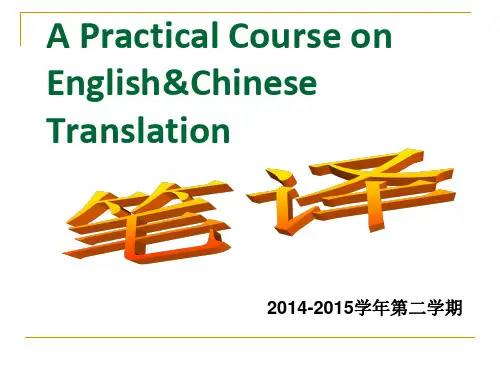
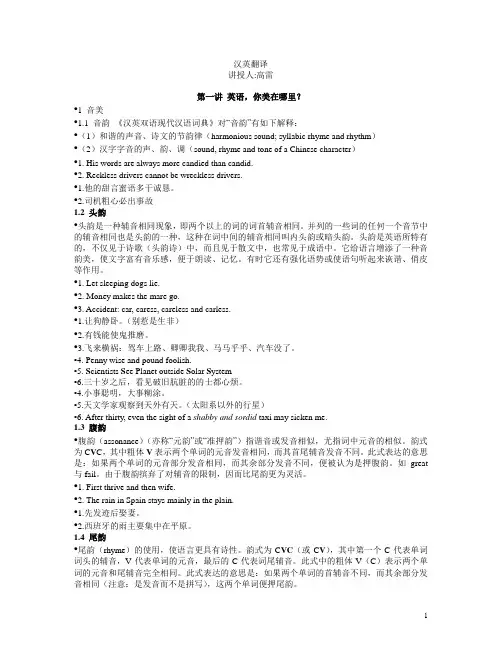
汉英翻译讲授人:高雷第一讲英语,你美在哪里?•1 音美•1.1 音韵《汉英双语现代汉语词典》对―音韵‖有如下解释:•(1)和谐的声音、诗文的节韵律(harmonious sound; syllabic rhyme and rhythm)•(2)汉字字音的声、韵、调(sound, rhyme and tone of a Chinese character)•1. His words are always more candied than candid.•2. Reckless drivers cannot be wreckless drivers.•1.他的甜言蜜语多于诚恳。
•2.司机粗心必出事故1.2 头韵•头韵是一种辅音相同现象,即两个以上的词的词首辅音相同。
并列的一些词的任何一个音节中的辅音相同也是头韵的一种,这种在词中间的辅音相同叫内头韵或暗头韵。
头韵是英语所特有的,不仅见于诗歌(头韵诗)中,而且见于散文中,也常见于成语中。
它给语言增添了一种音韵美,使文字富有音乐感,便于朗读、记忆。
有时它还有强化语势或使语句听起来诙谐、俏皮等作用。
•1. Let sleeping dogs lie.•2. Money makes the mare go.•3. Accident: car, caress, careless and carless.•1.让狗静卧。
(别惹是生非)•2.有钱能使鬼推磨。
•3.飞来横祸:驾车上路、卿卿我我、马马乎乎、汽车没了。
•4. Penny wise and pound foolish.•5. S cientists S ee Planet outside S olar S ystem•6.三十岁之后,看见破旧肮脏的的士都心烦。
•4.小事聪明,大事糊涂。
•5.天文学家观察到天外有天。
(太阳系以外的行星)•6. After thirty, even the sight of a shabby and sordid taxi may sicken me.1.3 腹韵•腹韵(assonance)(亦称―元韵‖或―准押韵‖)指谐音或发音相似,尤指词中元音的相似。
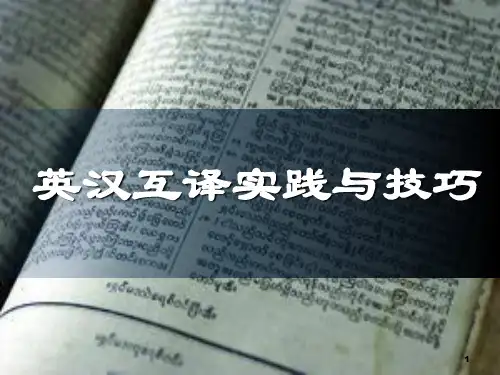
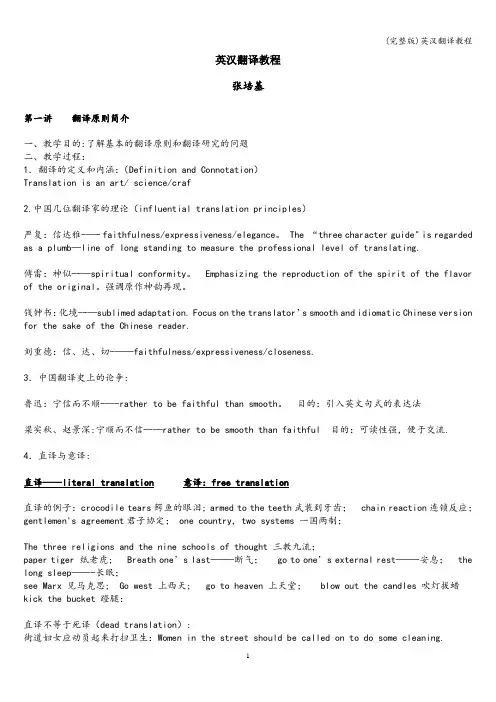
英汉翻译教程张培基第一讲翻译原则简介一、教学目的:了解基本的翻译原则和翻译研究的问题二、教学过程:1.翻译的定义和内涵:(Definition and Connotation)Translation is an art/ science/craf2.中国几位翻译家的理论(influential translation principles)严复:信达雅-—- faithfulness/expressiveness/elegance。
The “three character guide" is regarded as a plumb—line of long standing to measure the professional level of translating.傅雷:神似--—spiritual conformity。
Emphasizing the reproduction of the spirit of the flavor of the original。
强调原作神韵再现。
钱钟书:化境--—sublimed adaptation. Focus on the translator’s smooth and idiomatic Chinese version for the sake of the Chinese reader.刘重德:信、达、切-——faithfulness/expressiveness/closeness.3.中国翻译史上的论争:鲁迅:宁信而不顺-—-rather to be faithful than smooth。
目的:引入英文句式的表达法梁实秋、赵景深:宁顺而不信--—rather to be smooth than faithful 目的:可读性强,便于交流.4.直译与意译:直译—--literal translation意译:free translation直译的例子:crocodile tears鳄鱼的眼泪; armed to the teeth武装到牙齿; chain reaction连锁反应;gentlemen's agreement君子协定; one country, two systems 一国两制;The three religions and the nine schools of thought 三教九流;paper tiger 纸老虎; Breath one’s last——-断气; go to one’s external rest——-安息; the long sleep——-长眠;see Marx 见马克思; Go west 上西天; go to heaven 上天堂; blow out the candles 吹灯拔蜡kick the bucket 蹬腿:直译不等于死译(dead translation):街道妇女应动员起来打扫卫生:Women in the street should be called on to do some cleaning.“In the street" should be replaced by “in the community”.她一大早起床,进城,见到了她的公爹:She got up early, went to the town and saw her public father。
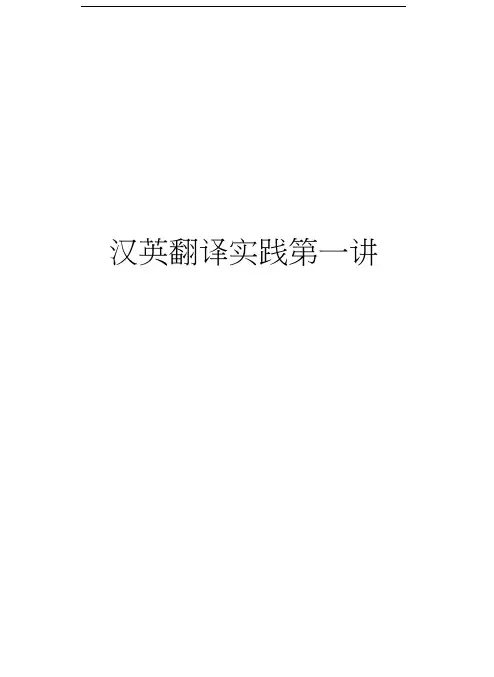
汉英翻译实践第一讲PART I:I. 原文(Source Text)水桥在巴拿马,有一座世界闻名的“水桥”,那就是巴拿马运河。
去年暑假,我跟着爸爸妈妈去巴拿马运河游览观光,至今还记忆犹新。
我们乘机抵达巴拿马城,然后搭上了一艘游轮,从巴尔博亚港进入运河。
船行13公里后,便到了运河的第一组水闸1。
巴拿马运河就是通过水闸的关与开,让船舰跨越陆地的一座“水桥” 2。
我们开始“上桥”了。
船驶进闸池之后,厚2米,高、宽各20米,重数百吨的钢闸门便缓缓地关闭,闸池里开始注水。
几分钟后,水涨船高3。
游轮在两岸电力机车的牵引下缓缓前进。
这样连升两级之后,船已经升高了16米。
出闸后,再驶过一个小湖,又到了第二组水闸。
经过这座水闸,船又升高了9.5米。
这样,船已高出海平面26米,进入“桥顶”4。
我们的游船驶进了长达13公里的主航道,只见5两岸山6如刀削,绿树红花,景色十分秀丽7。
游船出了峡谷,驶入了宽阔的加通湖。
湖水倒映着远山白云,美丽的小岛时隐时现8。
在湖中悠悠航行38公里之后,船来到了加通水闸,从此进入了“下桥”段。
这座水闸共有三级,犹如三个巨大的台阶。
游船经过加通水闸后,已经降到了与大西洋水面相同的高度。
当船驶入利蒙湾时,美丽的加勒比海便出现在眼前9。
我们从太平洋来到大西洋10,彼此隔离的大洋因为有了巴拿马运河而相通。
运河全长81.8公里,宽度由150米到304米不等。
5万吨级的巨轮,日夜畅通无阻。
它无愧于“世界桥梁”的称誉。
我由衷地赞美人类改造自然的智慧和勇气!我敬佩你,巴拿马人民!导游告诉我们,巴拿马人民是有志气的。
他们一方面正在改造现在这条运河;另一方面,还准备新建一条更长的运河,预计工程需要10年才能完成,它将成为人类有史以来最大的工程11。
我们期待着它早日完成。
II. 理解难点提示(Suggestions for Comprehension)1. 这里的“水闸”指什么?参考下文的“进闸池”、“出闸”。

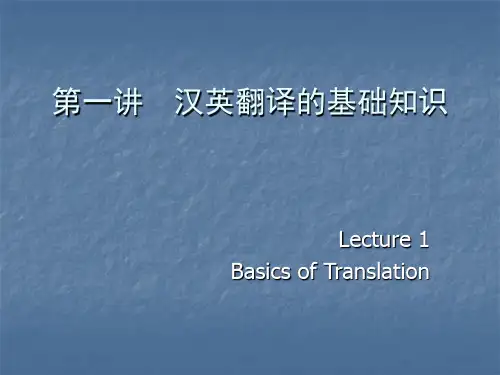
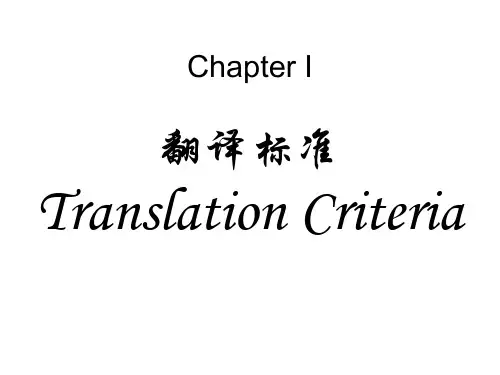
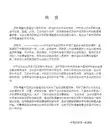
Chapter 1 Introduction of TranslationTeaching Objects:Ss will be able to grasp:1. History of translation in China;2. The definition of translation;3. Types of translation;4. The requirements for translators.Emphasizes:1. The definition of translation;2. Types of translation;3. The requirements for translators.Difficulties:1. The definition of translation;2. Types of translation;Teaching StepsBefore we formally begin to learn how to translate, there is some basic knowledge we must know. So in the first class, we are going to learn something necessary for translation. And they will be undoubtedly helpful for your translation.T asks Ss about what is translation in their opinion.(10 minutes)T encourages Ss if they are right and corrects their ideas if they are wrong.Part I. Introduction of the course. (20 minutes)1. Basic contents of the course.2. Requirements for students.3. Scoring of the course.4. After-class practice.Part II. The History of Translation in China. (35 minutes)In the history of China, there have been a lot of people who have made contribution for translation, such as 鲁迅,林语堂. And as you know, the famous criteria for translation is “信达雅”(here T can ask Ss if they know the criteria). So we are going to learn some important theory by famous translators, maybe litterateur. And of course, all their ideas are surrounded with the criteria of translation.1、三国时期,支谦著《法华经序》,“直译求信”。
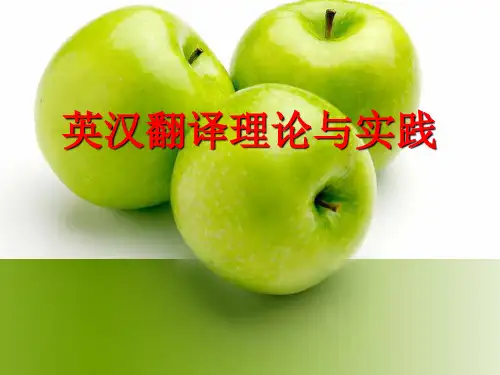
广西师范学院《英汉互译(一)》课程教案编号: 15-1 开课单位:外语系授课教研室:翻译写作课程名称:《英汉互译(一)》授课教师:唐旭光教材:《新编英汉互译教程》,授课对象:06级英语专业2、3、5班《英汉互译(一)》第一讲翻译简论与主要翻译方法(A Brief Discussion of Translation and Major Translation Approaches)1. IntroductionTranslation studies started along with translation practice. Translation theories developed flourishingly in the 20th century, especially in the second half of the last century.In fact, translation, which is a very complex phenomenon, is related to different disciplines, such as linguistics, psychology, sociology, cultural anthropology, communication theory, literary criticism, aesthetics, and semiotics. As translation study is a cross-discipline and cross-culture subject involving many aspects of human knowledge, the lack of a fully acceptable theory of translation should not come as a surprise. Meanwhile, quite a number of translation approaches and strategies have become universally acceptable and widely applicable. They are, of course, the fruits of many translation theorists and translation practitioners at home and abroad.2.The Origin of TranslationLanguage makes it possible for people to communicate with one another freely so as to complete important tasks in human life. Translation makes it possible for people from different languages to communicate with one another so as to complete important tasks in their life.Theodore Savory points out, “Translation is almost as old as original authorship and has a history as honorable and as complex as that of any other branch of literature”(申雨平, 2002:4).In Zhou Dynasty there were different forms of address for translators in different places. “Translators are called Ji in the east, Xiang in the south, Didi in the west, andYi in the north(东方曰寄,南方曰象,西方曰狄鞮,北方曰译)”(陈福康, 2000:3).3. Function of TranslationIt has helped people to better communicate with one another, and in the mean time it has facilitated the development of culture and civilization of all nations, such as the Sutra translation (佛经翻译)in China and the Bible translation in Western countries.Actually, translation, as a means to bridge different cultures, has been playing a very important role in promoting global economic and cultural development, and China in particular benefits a great deal from translation, which is obvious to all.4. Nature of translationOne school of theorists maintain that any interpretation is translation. Translation thus defined includes intra-lingual rewording(语言内的重新措辞), inter-lingual (语言之间的翻译或语际翻译)translation and inter-semiotic transmutation(符号转换).But most scholars who are interested in translation maintain that translation is a communicative activity which entails a most adequate or identical reproduction in a target language of a written message or text in a source language.5. Definition of translation in our textbook as follows: Translation or translating is a communicative activity or dynamic process in which the translator makes great effort to thoroughly comprehend a written message or text in the source language and works very hard to achieve an adequate or an almost identical reproduction in the target language version of the written source language message or text. In terms of its nature or character, translation is both an art and a science as well, since it calls for a good command of at least two languages, a flexible application of their rules, and some knowledge of at least two cultures, as well as a good grasp of the necessary translation theories.6. Other scholars’ viewpoints about the translation1). The traditional viewpoint about the nature of translation is that translation is an art only. This viewpoint is still maintained by Xu Yuanchong(许渊冲), a well-known professor at Beijing University, and a few other scholars.2). Professor Liu Zhongde vigorously advocates that translation is a science as well as an art mainly because of the following reasons:Firstly, like any other art and science, translation requires a good grasp and a flexible use of the necessary specialized knowledge and skills.Secondly, like any other art and science, translation calls for independent, honest and creative effort.Thirdly, just like any other art and science, translation demands that the translator be very careful about and highly responsible for his or her work.7. Principle for translationThe 13 statements on page 81). A translation must reproduce the words of the SLT(Source Language Text).2). A translation must reproduce the ideas (meaning) of the SLT.3). A translation should read like an original work.4). A translation should read like a translation.5). A translation should reflect the style of the original.6). A translation should possess the style of the translator.7). A translation should retain the historical stylistic dimension of the SLT.8). A translation should read as a contemporary piece of literature.9). A translation may add to or omit from the original.10). A translation may never add to or omit from the original.11). A translation should let the readers of the SLT and the target language text (TLT) have essentially the same response.12). A translation should convey what the SLT author intends to convey.13). A translation should satisfy the need of the client.Evidently, though each of the above statements is right in a certain sense, yet it is not adequate or comprehensive enough to serve as a translation principle. Some of the principles proposed by various translation theorists can find their expression in the statements given above. Interlinear translation is an illustration of the first statement. Yan Fu’s three-character principle can be a combination of statements 2, 3 and 6. Nida’s functional equivalence is best express ed in statement 11.8. Yan Fu’s Considerations for translation?Strictly speaking, a translation theory in its true sense in China originated from Yan Fu(严复). He proposed the famous triple principle for translation, namely, faithfulness(信), expressiveness(达) and elegance(雅).1). His faithfulness means that the translated text should be faithful to the original text, ie, the version should keep the content or ideas of the original.2). His expressiveness means that the translated text should be expressive and coherent without anything awkward. In other words, his expressiveness requires that the version should be fluid, smooth, and easy to read and understand.3). His elegance demands that the translated text should be exquisite and that its style ought to be very graceful.9. Professor Liu Zhongde argues against “elegance” as a principle for translation of the original styleHe argued eloquently against “elegance” as a principle for translation of the original style. We all know that not all works are characterized by the elegant style. Different writers display different styles. For instance, Lenin wrote in a bold style, and Hemingway wrote in a simple, symbolic style. Even the same writer shows different styles on different occasions for different purposes. Naturally, different works demonstrate different styles. Thus, it is impossible & absolutely wrong to achieve the effect of elegance in the translated text if the style of the original is not elegant.10. The compiler of the textbook in favor of “closeness”1). We are in favor of Professor Liu’s triple translation principle. He changed Yan Fu’s “elegance” into “closeness”, which represents his contribution to the translation theory. His “closeness” is central in meaning. It is suitable for translation of all types of texts with different styles.2). If the original text is characterized by the elegant style, the translator should do his utmost to render it into a graceful text in the target language whose style is close to the original elegant style.If the original style is highly technical with a wealth of technical terms, thetranslator ought to employ plenty of corresponding technical terms in the target language and make the translated style as close to the original technical style as possible.3). If the original style is colloquial with a lot of informal words and colloquial sentences, the translator should translate it into a text with an informal style as close as possible to the original one by using many colloquial words and informal sentences.If the original style is ornate, the translator should follow suit and make effort to render the translated style as close to the original as possible.If the original text contains some vulgar words and sentences, the translator is not entitled to replace them with elegant words or sentences, and he should reproduce the original by using some corresponding vulgar words and sentences in the receptor language. Translators are duty-bound to do so, for the simple reason that they are translators.4). As we know, Yan Fu’s triple translation principle is highly concise and well rhymed and quite easy to learn by heart, which is one of the reasons why it is still very popular in China today.Professor Liu’s triple principle is similar to Yan Fu’s in that it is equally concise and easy to remember.Though Professor Liu’s triple principle is n ot rhymed, yet it is very forceful and impressive, for the Chinese character “切” is uttered in the falling tone, carrying the implication that faithfully conveying the original style or rendering the translated style as close to the original as possible is absolutely necessary and worth the translator’s great effort.11. Nida’s principle for translationEugene A. Nida and Taber stated emphatically (1969:12): “Translation consists in reproducing in the receptor language the closest natural equivalence of the source language message, first in terms of meaning and secondly in terms of style”.His dynamic equivalence is defined as a translation principle, according to which the translator seeks to translate the meaning of the original in such a way that the target language text wording will produce the same impact on the target text audience as the original wording does upon the source text audience. Later on, Nida changed “dynamic equivalence” into “functional equivalence”, because it seemed much more satisfactory to use the expression “functional equivalence” in describing the degree of adequacy of a translation.12. The literal translation approachProfessor Liu Zhongde (1994: 172) defines literal translation as follows: “In the process of translation, literal translation treats sentences as basic units and at the same time takes the whole passage into consideration; a translator who attaches great importance to literal translation does his or her best to reproduce the ideas and writing style of the original work, retaining in the version as many rhetorical devices and sentence structures of the original as possible.”ExamplesHe is said to be a rough diamond.人们说他是一块浑金璞玉。
英汉翻译讲座(复旦大学讲义)unit1-5英汉翻译讲座(复旦大学讲义)Unit 1I. 英汉翻译原理第一讲:什么是翻译?【例1】 The history of a tree from the time it starts in the forest until the boards which it yields are used, would form an interesting and, in many instances, an exciting story.(“×”号表示译文有问题,下同)×树的历史开始于森林中,直到生产为木板后被使用为止,成为一个有趣且有许多事例的激动人心的故事。
上面这句话的原文实际上主要说了两点内容:1、树的历史的起迄时间2、树的历史是怎样一回事【译文】一棵树,从它在森林中生长起直到被制成木板使用为止,这段历史会构成一个饶有趣味的故事,在很多情况下这个故事十分激动人心。
【例2】There are two regulatory systems which interact. One timing system comes from the evidence of our senses and stomachs, and the periodicity we experience when living in a particular time zone.×有两个调节系统相互作用。
一个定时系统来自于我们的感官和胃的证明,就是当我们生活在一个特定的时区所经历的周期性。
【译文】人体有两个相互作用的时间调节系统。
一个时间调节系统依据感官和胃发出的信息,依据我们生活在某个时区所体验的周期性规律。
寻找对等词语和结构然后将其串接成句的翻译方法,常表现如下:1、简单语句的译文虽然生硬,但基本可读。
如:【例3】I can see three different types of composers in musical history, each of whom creates music in a somewhat different fashion.×我能看到音乐史上有三种不同的作曲家,他们中每一个人以某种不同的方式创作音乐。
汉英翻译讲义第一章汉英翻译的过程:正确理解——充分表达——校核翻译时译者要牢记:1. The meaning of a sign is determined by the meanings of other signs.2. Each word when used in a new context is a new word.3. Words have no meanings, and people have meanings for them.1.1正确理解(Correct Comprehension) 理解原文要对原文进行语言分析、语境分析和逻辑分析等1.扑克牌打烂了。
2. 他的衣服穿烂了。
3. 走一步看一步。
4. 我银行里为你挂个名,你白天去走走,晚上教教我儿子,一面找机会,好不好?《围城》5. 海上花园海上仙山6. 国际旅游年7. 汉语茶话会8. 世界风云9. 半边天10. 中国留学服务中心11. 经济半小时12. 此复印件与原件相符。
1.2 充分表达(Adequate Representation)13. 虽败犹荣14. 特快专递15. 真好玩儿!16. 招贴即撕17. 减肥法18.中央电视台对外广播节目19. 他的节目不理想。
译文1:Her performance is not ideal.译文2:Her performance is ____________________________________.译文3:Her performance is ____________________.20. 他的英文水平比我高。
译文1:His English level is higher than mine.译文2:He ____________________________ than I (do).译文3:He ____________________________in English than I (am).21. 这山望见那山高。
汉英翻译实践第一讲PART I:I. 原文(Source Text)水桥在巴拿马,有一座世界闻名的“水桥”,那就是巴拿马运河。
去年暑假,我跟着爸爸妈妈去巴拿马运河游览观光,至今还记忆犹新。
我们乘机抵达巴拿马城,然后搭上了一艘游轮,从巴尔博亚港进入运河。
船行13公里后,便到了运河的第一组水闸1。
巴拿马运河就是通过水闸的关与开,让船舰跨越陆地的一座“水桥” 2。
我们开始“上桥”了。
船驶进闸池之后,厚2米,高、宽各20米,重数百吨的钢闸门便缓缓地关闭,闸池里开始注水。
几分钟后,水涨船高3。
游轮在两岸电力机车的牵引下缓缓前进。
这样连升两级之后,船已经升高了16米。
出闸后,再驶过一个小湖,又到了第二组水闸。
经过这座水闸,船又升高了9.5米。
这样,船已高出海平面26米,进入“桥顶” 4。
我们的游船驶进了长达13公里的主航道,只见5两岸山6如刀削,绿树红花,景色十分秀丽7。
游船出了峡谷,驶入了宽阔的加通湖。
湖水倒映着远山白云,美丽的小岛时隐时现8。
在湖中悠悠航行38公里之后,船来到了加通水闸,从此进入了“下桥”段。
这座水闸共有三级,犹如三个巨大的台阶。
游船经过加通水闸后,已经降到了与大西洋水面相同的高度。
当船驶入利蒙湾时,美丽的加勒比海便出现在眼前9。
我们从太平洋来到大西洋10,彼此隔离的大洋因为有了巴拿马运河而相通。
运河全长81.8公里,宽度由150米到304米不等。
5万吨级的巨轮,日夜畅通无阻。
它无愧于“世界桥梁”的称誉。
我由衷地赞美人类改造自然的智慧和勇气!我敬佩你,巴拿马人民!导游告诉我们,巴拿马人民是有志气的。
他们一方面正在改造现在这条运河;另一方面,还准备新建一条更长的运河,预计工程需要10年才能完成,它将成为人类有史以来最大的工程11。
我们期待着它早日完成。
II. 理解难点提示(Suggestions for Comprehension)1. 这里的“水闸”指什么?参考下文的“进闸池”、“出闸”。
2. 为什么称巴拿马运河为“水桥”?3.“涨、高”指“开始涨、高”,还是“涨、高”到了足够的高度?考虑上文的“几分钟后”。
4. 这里两个分句是否平起平坐?考虑上文已经说过船“升高了16米,又升高了9.5米”。
5. “只见”是不是真的在描写“我们”在干什么?考虑上文的主语是“我们的游船”,不是“我们”;上文的宾语是“主航道”,下文接着是“两岸”。
6. “山”指hills还是指mountains?考虑1)上文说“桥顶”只高出海平面26米; 2)地理知识:巴拿马地峡很窄。
7. (我们的游船驶进了)“长达13公里的主航道,只见两岸山如刀削,绿树红花,景色十分秀丽”中各部分的层次关系如何?考虑“主航道”与“山”的空间关系,“山”与“绿树红花”的空间关系,“山”与“景色十分秀丽”的物与属性的关系。
8. 这里的“时隐时现”什么意思?参考1)上文的“驶入”,下文的“悠悠航行”;2)常识:“隐、现”可由光线明暗造成,遮拦物的有无造成,也可由观察者移动造成。
9. “驶入”与“出现”同时,还是先后?利用常识“运动是相对的”。
10.“我们从太平洋来到大西洋”发生了,正在发生,还是将发生?考虑1)上文说“加勒比海便出现在眼前”;2)地理知识:加勒比海是大西洋的一部分。
11. 这些话是不是作者的话?1)上文说“导游告诉我们”; 2)作文知识:“巴拿马人民是有志气的”是论点,而论点需要论据。
III. 译文(Target Text)A Water BridgeAcross1 Panama runs2 a world-famous “water bridge”, and3 that is the Panama Canal. Last summer vacation I went with my parents on a sightseeing tour along it, which4 is still fresh in my memory.Having got5 to Panama City by air, we boarded a pleasure boat in the port of Balboa and sailed into the canal. The boat traveled 13 km and reached the first group of water locks. The Panama Canal is thus a “water bridge” that allows ships to cross land by the opening and closing of water locks.We began “getting onto the bridge”. When the boat had sailed into the lock chamber, the steel gate, 2 meters thick, 20 meters high and wide and hundreds of tons in weight, slowly closed, and water began running into the chamber, which continued for a few minutes6. The boat rose with the water and advanced slowly, pulled along by power cars along both banks. Two lifts like that raised the boat 16 meters7. It sailed out of the lock across a small lake and came to the second group of locks, which raised the boat another8 9.5 meters. In this way, the boat, now 26 meters above sea level, had g ot onto the “top of the bridge”. It sailed along the main channel, which stretched 13 km between beautiful hills as steep as if cut apart with a sword and covered with green trees and colorful flowers9.The boat sailed out of the gorge and into the wide Gatún Lake, with10 white clouds and distant hills reflected in it and pretty isles passing into and out of sight11. After a leisurely journey of 38 km on the lake12, the boat came to the Gatún Locks, and there began its “descent down the bridge”. The Gatún Locks, three in number, looked like so many13 gigantic steps. After getting14 through the locks, the boat had descended to the same level as the surface of the Atlantic Ocean. The beautiful Caribbean Sea came into view as it15 sailed into the Limón Bay.We had come16 from the Pacific to the Atlantic, two great oceans separated by land but linked by the Panama Canal. The canal is 81.8 km in length and 150 to 304 m in width. Ships of 50,000 tons can pass it unimpeded all around the clock17. It is truly worth y of the name of “the Bridge of the World”. Full of hearty praises18 am I for man’s wisdom and courage in transforming nature! I admire you, the people of Panama!The guide told us that the Panamanian people had high aspirations. On the one hand, they were19 working to improve the existent canal, and on the other hand, they were planning for an even longer one, which20, it was estimated, would take 10 years to complete, and which21 would be the greatest project in man’s history. We look forward to its early completion22.IV. 表达讲解(Explanation of Expression)1. “在”译为across是由canal的形状与其同Panama的位置关系决定的。
这是具体化。
2. “有”译为runs,是由canal的形状决定的。
这也是具体化。
3. 原文中没有“和”(意合),译文里用and(形合)。
英语里不能单用逗号连接两个分句。
4. 原文没有主语,是承前省,译文用了which,既提供了主语,又与前面的分句连接起来了。
改为it或that只有前一种作用,没有后一种作用。
5. 原文的“我们”在全句之首,译文中句首没有we,条件是原文句首用非限定分句或无动词分句。
6. 原文“几分钟后”属下句,译文which continued for a few minutes属上句,但描写的是同一事实,只是观察角度不同(视点转换)。